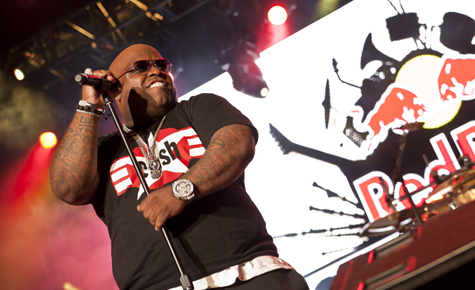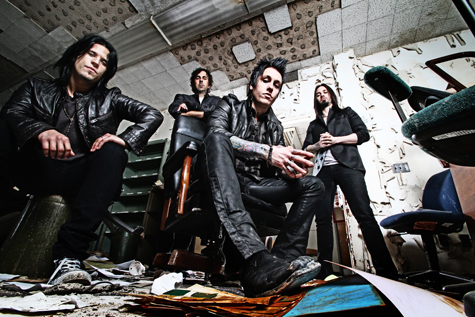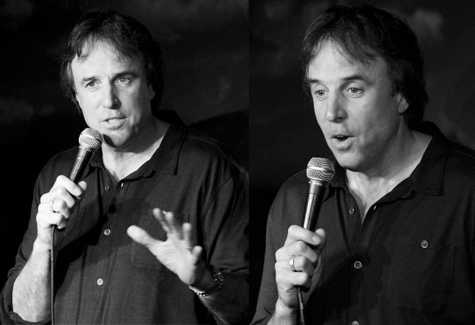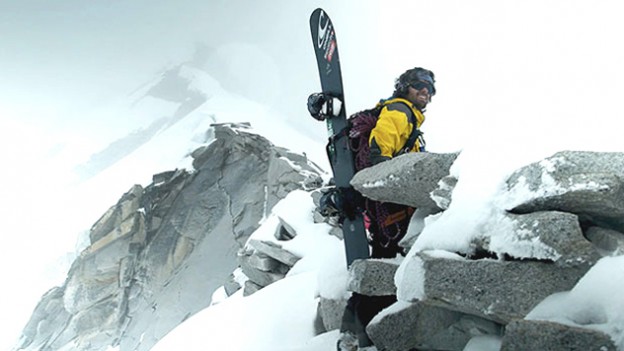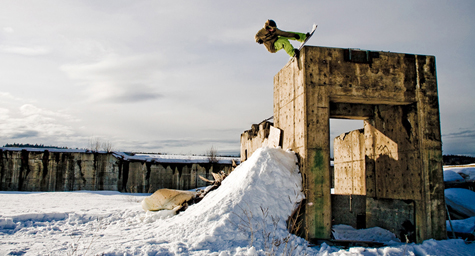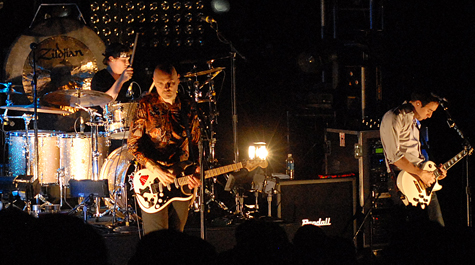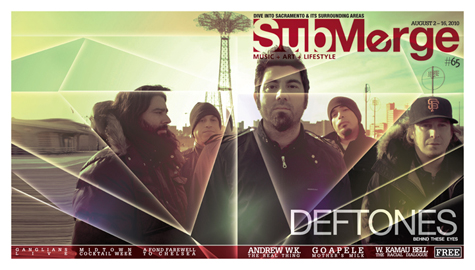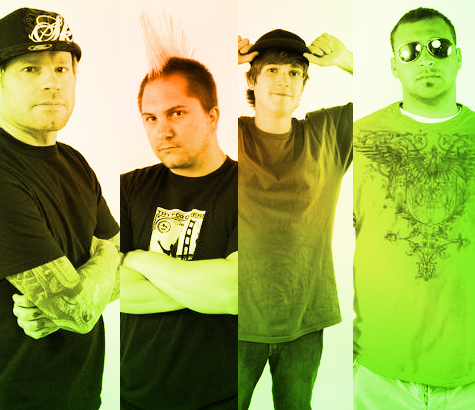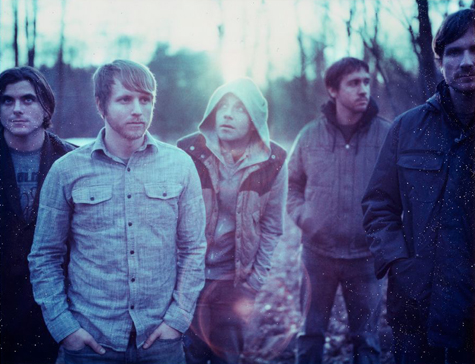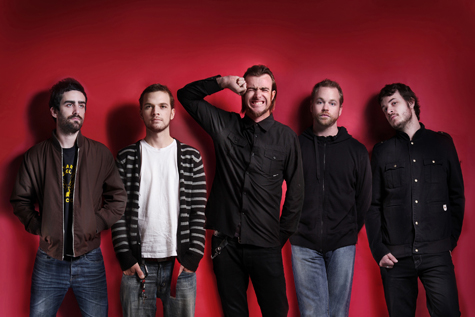Red Bull Soundclash: Cee Lo Green vs. The Ting Tings
Saturday, March 12, 2011
MGM Resorts International lot, Las Vegas, NV
Red Bull is a company known for doing things big, nay, huge. Most events they throw are spectacles that leave people thinking, “WTF?” or “How is that possible?” Example: New Year No Limits where every year Red Bull athletes push the boundaries of their respective sports, smashing world records left and right, leaving jaws on the floor all around the world. Or how about Red Bull Media House’s groundbreaking and awe-inspiring snowboarding films in collaboration with Travis Rice? That’s It, That’s All, released in 2008, and the upcoming film The Art of Flight (September 2011) are arguably two of the best films ever produced in their genre. Point being, anything Red Bull touches turns out epic.
This past weekend on March 12, their Soundclash event held in Las Vegas featuring Grammy Award winner Cee Lo Green and indie pop stars The Ting Tings was no different. Roughly 6,000 eager spring breakers crowded into the MGM Resorts International lot directly across from the Luxor (the giant pyramid looking building that shoots a beam of light up into space) to experience a concert unlike any they had ever seen. The set-up looked and felt more like a festival than a regular parking lot concert, with two giant stages facing each other on opposing ends of the lot, leaving the crowd and a giant DJ tower where host La La Anthony oversaw the event sandwiched in between.
Before the show started an informative video aired on all the giant screens around the venue that explained what we were about to see and hear. Then, it got underway. Round 1 was the “The Warm Up” where each act performed three original songs. Cee Lo performed “Lady Killer,” “Bright Lights” and the Gnarls Barkley hit “Crazy.” The Ting Tings responded with “Keep Your Head,” “Hit Me Down Sonny” and “Shut Up and Let Me Go,” which you have no doubt heard. It was featured in 2008 in a famous Apple commercial. Round 2 was “The Cover” which featured both acts covering the same song, The Clash’s “Should I Stay or Should I Go,” with their own personal twist on it. Cee Lo’s version was pretty a straight-forward, rockin’ rendition of the classic song, but The Ting Ting’s version had more depth and dynamics to it, progressing into a high-energy finish.

The Ting Tings // Photo by Garth Milan, Red Bull Photofiles
Round 3, “The Takeover,” was probably the most innovative and impressive round of all musically speaking. The concept seems simple enough: one band starts a song, the other band takes it over seamlessly halfway through and finishes it, but in reality it is extremely difficult to get the timing and pitch just perfect when taking over another band’s song, especially from about 100 yards away on a separate stage entirely. Each group started two songs; Cee Lo’s tracks were “Run” and “Smiley Faces,” (both technically Gnarls Barkley songs) and The Ting Tings songs were “Fruit Machine” and “Be the One.” This led to Round 4, which was called “The Clash” and highlighted the artists’ versatility by having them perform their songs in three different styles outside their comfort zone. The styles chosen were reggae, acoustic and rock/metal.
Finally, round 5 was “The Wildcard.” In this round, the bands were allowed to invite a special guest to perform with them on stage. The Ting Tings appropriately enlisted the help of an Elvis impersonator (this did take place in Vegas, after all) to help them with their hit single “That’s Not My Name,” a crowd favorite for sure. Cee Lo invited Khujo, T-Mo and Big Gipp to reunite Goodie Mob for a performance of “Get Rich to This.”
When round 5 ended the crowd somehow knew the show wasn’t done, Cee Lo hadn’t even performed his latest smash single “Fuck You,” which might go down as the past year’s most talked about, controversial song. After a few moments The Ting Tings joined Cee Lo on his stage and they busted into a collaborative version of the song, sending the crowd into a frantic sing-along. Afterward DJ Mick Boogie kept the party going for a bit, large crowds stayed and danced, but after a while everyone headed to Studio 54 inside MGM for the official Soundclash after party featuring The Glitch Mob. Once again, Red Bull does it properly.
Papa Roach’s Jacoby Shaddix is addicted to bringing the rock
Love ‘em or hate ‘em, there is no denying that Papa Roach has earned their rank as one of the most successful bands to come from the Sacramento region. They’ve sold upwards of 10 million records worldwide, have toured the globe for over a decade playing venues packed with adoring fans and have truly lived the rock ‘n’ roll lifestyle. But for every high point, there’s been a low. Be it battles with their record label or battles within the band itself, Papa Roach has shed its fair share of blood, sweat and tears, most notably when they parted ways with long-time drummer Dave Buckner in 2008. It wasn’t a smooth split. Buckner, who in the early ‘90s co-founded the band with vocalist Jacoby Shaddix, filed suit against the band saying that they owed him money. They ultimately settled out of court. Papa Roach has since continued on with new drummer Tony Palermo of the San Diego rock group Unwritten Law.
Through all the ups and downs, there have been a number of things keeping P-Roach pushing ahead, Shaddix explained during a recent interview with Submerge. “I would say our relationship with our fan base, the kids that are coming out to the shows being affected by the music,” he said. “We’ve just got that drive inside of us as a band. We’ve got this heart that just fucking pops. It’s all we got and it’s all we need. We all are living this dream, which sometimes can seem like a nightmare, but I’d sound like a bitch if I were to complain. We just love it.”
As for the incalculable hardships that always seem to creep their way into the picture, Shaddix said that after a career like theirs, he and his crew are ready to take on anything. “It’s always a challenge. You’re always up against a challenge,” he said. “But the members of this band are always up for it. I think it makes it easier for us as time goes by too because we’ve just seen so many genres come and go and so many trends come and go.” He chuckles. “We almost came and went.”
In the following interview, we chat with Shaddix about his band’s deep Sacramento roots, how making music is like a drug, their plans for a new full-length record and more. Be sure to catch Papa Roach live in Sacramento for their first time in years when they headline Ace of Spades two nights in a row on Feb. 25 and 26, 2011.
What are some of the first thoughts that come to mind when you think back to Papa Roach’s humble beginnings when you were gigging in and around Sacramento all of the time? Do you ever trip out on how far you’ve come?
For me it’s a daily kind of realization, more so when I’m home around the people that I was with. Not only am I with my band on the road, but then it’s like we’ve got sound guys and light guys, a whole crew, you know? I never had that back in the day. Then I come home, and I’m back around my wife. She’s been with me since I had Papa Roach in the very beginning. We’re old school. We go through our old photos, and we see pictures of me and my wife and my band from way back in the day. My band was in my wedding way back. It’s a trip, you know, especially when I come back home.
I used to go watch you guys in the late ‘90s at this little club near where I grew up, the Gaslighter Theater in Gilroy, Calif. Do you remember that place? That was right on the brink of when you guys were getting the major label deal and whatnot I think.
Fuck yeah, dude! That was a really cool time for P-Roach.
I tripped out when talking to Eric Rushing, longtime Sacramento music enthusiast and promoter, the other day about that era of P-Roach because he was like, “Yeah those were my shows even down there. I was at most of those shows!”
Yeah for these upcoming shows that we’re doing in Sacramento, just to interject on that point, it’s kind of a full circle for us 10 years later. Eric and Brett [Bair] have been very successful. Brett used to manage Papa Roach; we split the sheets, we’re still OK, and we’re friends and such. But it’s cool to see that people who started in Sacramento are all still around here killing it. That’s even kind of why we wanted to put the type of bill together that we put together.
Yeah that’s cool. It’s all Sacramento cred-bands.
Yeah, bring it on home!
So the first night it’s Track Fighter, Will Haven and you guys. The second night it’s Lonely Kings, MC Rut and you guys. So many good Sacramento-based bands! I’m especially digging MC Rut lately. They’ve got a crazy work ethic. Are you familiar?
Fuck yeah, dude. That record is one of my favorites. I mean you’ve got to work hard in this business no matter what. If you want to make it, you’ve got to go in and slug it out in the trenches and build a fan base by playing rock shows. That’s the proving ground for rock music is touring. If you come with a hot song for a minute, that’s all good, but can you go out and tour and pack houses and rock audiences throughout America? Not just like San Francisco and New York, I’m talking, like America, you know what I mean?
Bringing it back to Sacramento for a second, don’t you guys own a studio space downtown? What’s that space all about?
Yeah right now it’s just pretty much essentially a demo studio for Papa Roach, and we’ll have some bands go in there. Like Dance Gavin Dance is going in a few days. They’ll be in there making some noise. Michael Rosen, he used to run out of J Street Recorders, Brian Wheat’s studio, he’s been bringing down some of his gear. He’s got really good gear, and he’s pretty much running it like a proper studio at times with bands. So that’s cool as well. We just don’t want it to collect dust while we’re out on the road.
Must be nice to just to get new riffs and song ideas recorded fast?
Yeah, exactly. I just got a new jam from Tobin [Esperance, bass] today actually. He programmed it on his computer, did the beats himself. There’s no guitar on it yet. It’s just keyboard sounds right now, but it’s like Papa Roach meets…I don’t know, it’s real good though.
So it’s sounding like there’s going to be another full-length ready for release sometime when? Next year?
Pretty much what we’re doing is this, Doomsday Radio, 2012, Papa Roach.
Oh really? I didn’t see that anywhere in any of my research! Is that a working title?
Yup. Working title, Doomsday Radio. There you go, print it.
Throughout the years Papa Roach has morphed quite a bit musically; it always seems like you’re progressing your sound. Can you talk a little about the many phases of your band?
I think for us it’s always been, “Go where the music takes us.” That’s the goal with Papa Roach: If it moves us, we think it will move our fans, and sometimes that’s true and sometimes it’s not. I think more times than not it has moved our fans. That progression that you speak of, we’re still in it. The track that Tobin just sent me, I was like, “Oh shit here we going again, we’re flippin’ it up.” But I’m into it, man. Music is this drug, and you want to try all different types of them. It’s like sex, you know, it’s like you do it the same way over and over and it just gets boring, so you’ve got to flip it up, put a wig on her, hit it doggy style. Switch it up.
What sort of vibe does the new song that Tobin sent you have? I read somewhere that Jerry [Horton, guitar] said the new record will have more electronic elements or something like that?
Oh yeah, for sure. It’s like somewhere between Prodigy meets Nine Inch Nails meets Papa Roach. It’s still got our sound to it, though, like when you hear the groove and the vibe, it’s still us, it’s just sometimes we want to use that texture in the music. I think we started to dabble in it with songs like “Burn” and “Kick in the Teeth” [off of 2010’s Time for Annihilation…On the Record and On the Road]. I think that it’s fun and our fans are receptive to it, and we like it because it opens up a whole new floodgate for us. I think it can make our music more beat-driven at times, which will be fun.
What’s one big goal of yours for the next record?
I don’t want to make a record that sounds like I’m a 35-year-old man, because I am a 35-year-old man, or I’m going to be, but I’m an exciting motherfucker when it comes to making music. I don’t want to make music that sounds compromised. That’s the goal for the next record is to kind of–and we’ve discussed this together–is to make a record that’s a little bit more experimental at times and a little bit more progressive. The last couple records have been song, song, song, etc. If you look back at one of our first releases, Old Friends from Young Years, there was a whole concept behind the way the record was laid out. I think we want to do something like that again.
Like as far as flow and transition tracks and whatnot?
Exactly, just to kind of dig deeper and make it more of an experience this time around. Not really a concept record, but something that is more than just song, song, song, song.
Even to the way that we’re going to do music videos in the future and the way that the band is imaged as well. For us, it’s a goal to kind of evolve all elements of what we do just a bit.
You might be getting older, but I sense that you are just as hungry as ever to succeed.
Yeah, look at the Chili Peppers. You don’t think of it that way. You think it’s just timeless. That’s what we’re going for. We’ve got a long, long road ahead of us. This is just another step in the path for us.
Papa Roach has heavy staying power in the music business, doesn’t it? It’s been so many years, but you guys remain relevant.
We definitely don’t take that shit for granted. But the fight is not over, dude. You look at a band like Green Day, they made that record, you know what I’m saying? For us, we still feel like we have that record in us. We still feel like we haven’t made the record of our career. Maybe it’s just that junkie inside me.
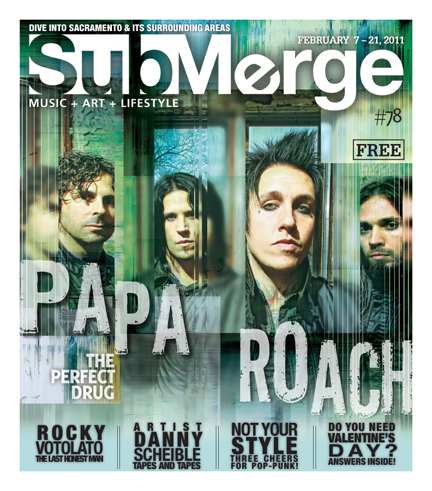
Papa Roach will play live in Sacramento for the first time in years at Ace of Spades (1417 R Street) on Feb. 25 and 26, 2011. Tickets are available at Dimple Records, The Beat, Armadillo (in Davis) and online at aceofspadessac.com. Grab their latest album, Time for Annihilation…On the Record and On the Road, a collection of nine live renditions of P-Roach hits and five newly recorded tracks, at record stores everywhere or through any major online retailer.
Veteran funnyman Kevin Nealon strives to keep current
Many experts argue that laughter is good for you. They say it’s therapeutic to the mind, body and soul, that it relaxes the whole body and even boosts the immune system. If this is the case, comedian/actor Kevin Nealon has been healing millions of people worldwide for decades. From 1986 to 1995, Nealon was hilarious on Saturday Night Live (remember The Subliminal Man? How about Hanz and Franz?); he also had us rolling on the floor with his appearances in such films as Happy Gilmore, The Wedding Singer and Grandma’s Boy, and he’s currently keeping the laughs going as Doug Wilson, the stoner city councilman, accountant and part-time pot dealer on the hit Showtime series Weeds and as the lead in Glenn Martin, DDS, a stop-motion animated series on Nick at Nite.
One thing that’s stayed consistent throughout his lengthy career is his love for doing stand-up. He says that stand-up came first and then the acting gigs flowed. “That’s what I really wanted to do was stand-up comedy,” Nealon says of his early years. “The acting came secondary. Stand-up was what I loved and then I got on talk shows and then I was in that Roxanne movie with Steve Martin and I got on SNL in 1986, but I never stopped doing stand-up.”
Lucky for us he still hasn’t stopped, and on Jan. 14 and 15, 2011 he’ll bring his act to Tommy T’s Comedy Club in Rancho Cordova. Nealon was gracious enough to take some time to chat with Submerge while in Hawaii on vacation, sort of.
How’s Hawaii? Are you there for fun time or work time?
Well, it’s rest time to be ready for work. Or, you know, to recover from work I guess [laughs]. I don’t know. I had an interesting morning, though. I was at breakfast and this guy starting choking and a friend of mine did the Heimlich maneuver on him. I’d never saw that in person. He saved the guy’s life.
So you were just sitting there watching it all?
I was there just watching and enjoying my breakfast. I didn’t know that there was entertainment with the breakfast.
Talk about all-inclusive.
Yeah, but I’d never seen that actually happen in real life.
I’ve never seen that happen in real life either, but it’s one of those situations that’s depicted in so many movies and TV shows that you feel like you’ve seen it happen, you know?
Yeah and It’s usually in comedies where you see it, you know, where the thing pops out of the person’s mouth and goes flying across the room [laughs].
Probably wasn’t so funny in real life.
No, it was funny.
You’re going to appear in a ton of films this year. For example, Just Go With It, the Adam Sandler and Jennifer Anniston flick. You play a character called Adon, right? What can you tell us about that?
Well, Adon is Middle Eastern, and he’s a plastic surgery junky. He can’t get enough and he’s fairly persuasive to the people around him. He just likes to have a good time and likes to look good.
I saw something on your website about that role that said, “You might not even recognize me.” Was there major makeup involved?
Oh yeah, it was six hours in the makeup chair. I think we shot like three or four days and they only used one scene. That’s the way movies are. It was fun doing the movie though, it was fun hanging out with Jennifer and Sandler and I think it’s going to be a funny movie.
Heidi Montag plays your wife, right? That seems kind of fitting considering she’s a real-life plastic surgery addict. How was it working with her?
It was nice. She was very sweet. It couldn’t have been more pleasant. She was very eager.
How about the Nick Swardson and Christina Ricci porn-tinged comedy called Born to Be a Star. Who do you play in that?
That’s a fun one; I can’t wait until that one comes out! That’s a really funny film. I play Nick Swardson’s character’s abusive roommate trying to connect with Christina Ricci’s character. Nick’s character becomes my roommate because she asks my character to take him in and I’m just totally abusive to him. I don’t think you’ve seen anything more abusive.
Couple more. How about Jack and Jill, the one where Adam Sandler plays, well, Jack and Jill. How do you fit into that one?
Well I just play a doctor at the beginning of that film delivering two kids. And that’s actually Sandler’s sister who’s giving the baby in real life and his brother plays her husband [laughs].
Keeping it in the fam! Finally, there’s And They’re Off with Martin Mull and Sean Astin. Who do you play in that one?
That was a fun movie. My wife and I did that together. It’s more of an improv scene, which was really fun. Martin Mull and Sean Astin were great to work with. It was just a great day, one of those days where it clicks and it just goes by in an instant.
You thrive in improv situations, don’t you?
Yeah, we had a good time doing it. My wife was in The Groundlings for a while, the comedy company, so she loves improv too and she’s a great actress. It was kind of like playing all day, you know, and when you work with Martin Mull and Sean Astin it’s just a real heyday.
You’re a really busy guy! How do you shuffle all your projects?
Well, you know, it sounds like I’m busy, but for example I did that Swardson film over a year ago I think.
So on paper you’re busy?
Yeah, on paper it looks like I’m really busy and people tell me, “You got to slow down,” but really I have so much free time, it’s crazy.
As far as work ethic goes, whom do you look up to in the comedy world?
Well first and foremost Adam Sandler, that guy is a workhorse. He’s constantly working and looking forward to the next project. Sarah Silverman, Gary Shandling was also a big influence for me. If you go back a little bit, Albert Brooks. Steve Martin of course–he’s a genius.
You had a stand-up DVD out a while back called Now Hear Me Out. When can we expect another one?
I am actually working on one, yeah, that’s one of the reasons I’m doing so much stand-up is to come up with another special. That was my first one-hour special after all those years of doing stand-up. I figured it was time to do one. I’m such a perfectionist in a lot of ways, and I keep waiting to come up with better material, but you know what, that may never happen [laughs].
How tough is it for comedians to compile an hour’s worth of solid material to do a full-on special like that? It seems like it’s the equivalent of writing an album for a musician, or a screenplay for a writer, or a book for a novelist or something like that.
It is intense depending on the comic and how often they try their new material and write. Some of these comics come out with a new special every year, and they’re kind of not as good as their first special, because that’s when they had all of their material. Unlike musicians. I was just reading “The Beatles: 100 Greatest Songs” in Rolling Stone, and they had deadlines when they had to come up with songs, so they were kind of like forced to write songs by a certain time. Sometimes they came up with a great song, sometimes not so great, but they had record deadlines. But comedy has to be a little more organic, you know? You have to really find the material and hone it down. I’ve done stuff on talk shows, and I look back on it now and I think, “What happened to that hunk?” but I didn’t have the other half of that bit at that point.
When it comes to writing new material for your stand-up routine, where do you usually find your inspiration?
A lot of it is based on my life, you know, an exaggeration of my life. Or you know it’s me sitting with friends, talking and me coming up with something funny because I’m relaxed and loose. Like I was thinking about how people meditate, and I was thinking my New Year’s resolution would be to relax more, so I thought, “Maybe I should start meditating.” I tried that, but it becomes more of a worrying thing for me, I just start worrying. Then I thought maybe that’s because my mantra is, “Ohhhhh noooooo.”
Did becoming a father change the way you write your stand-up material?
Well, he’ll [Gable, Nealon’s son] be 4 at the end of January. Anytime you have a big life change like that, it kind of shifts your thinking pattern. It really was an influence on my writing, but I don’t have a lot of material about being a father. I had a lot of material about going through the pregnancy, in fact I wrote a book about it. As far as being a father, I haven’t really dissected that too much. I’m just kind of enjoying it. Some club owner told me once, “The best way to kill your career is just to do stuff about being a father.”
So that’s really stuck with you?
It has stuck a little, but I don’t know if it’s always true. I haven’t seen Seinfeld’s act lately, but I’m sure even he’s doing stuff about being a Dad. I mean Bill Cosby based his whole career on it.
Have you showed your son any of your movies or your stand-up DVD yet? If so, how did he react?
Oh yeah, he’s seen me in a few things. He’s watched Glen Martin, DDS and he heard my voice and recognized it. He points and he laughs and he goes, “Look it’s Daddy.” I think he thinks I go down to a Walmart or something and just put myself in a movie [laughs].
Weeds has had a ton of success; and in my opinion, your character, Doug Wilson, is one of the funnier ones on the show. How do you prepare for that sort of “stoner-ish” role? Because contrary to popular belief, you don’t smoke pot, do you?
That’s right. I think I go in with the attitude of a friend of mine who smokes a lot of pot, in that he basically doesn’t really have any concerns about the rest of the world. It’s kind of like he’s just looking out for what he enjoys doing, and if he has to make a decision between what’s right and what’s good for him, he’ll usually pick what’s good for him [laughs]. So I think it’s that kind of mental attitude that my character assumes, and he’s basically just out to have fun.
I bet you get people coming up to you all the time like, “You’re on Weeds, let’s go smoke a doobie!” That’s probably annoying, huh?
[Laughs] We went to Haight-Ashbury about a year ago, and you wouldn’t believe the amount people gave us. We were walking around, my wife and I, and I just had a hand full of pot.
I’m always curious about this with comedians: what makes you laugh?
Um, usually the Heimlich maneuver.
So this morning you were set, then huh?
Yeah, I fell off my chair. Real people doing unpredictable things makes me laugh. You know, Candid Camera used to be one of my favorite shows. You know what I mean, though, people not trying to be funny and it just happens. Or kids–kids are really funny. Just their rationale and thinking is just so funny because they are just so innocent. I like dry humor, you know, like Flight of the Concords and Eastbound and Down.
You just seem to be getting funnier with age. You’re like a fine wine or something. How much longer do you see yourself making people laugh?
Well yeah, I don’t think I’ll ever retire because I enjoy doing this. But you know, I start thinking about that as I get older. I think the most important thing is to kind of stay connected and relevant and to stay on top of things, so you can kind of relate to people that are younger than you.
With close to 1.3 million Twitter followers, I’d say you’re pretty on top of things.
[Laughs] Yeah, I guess so. Anyways, that’s my objective: stay current as much as possible.
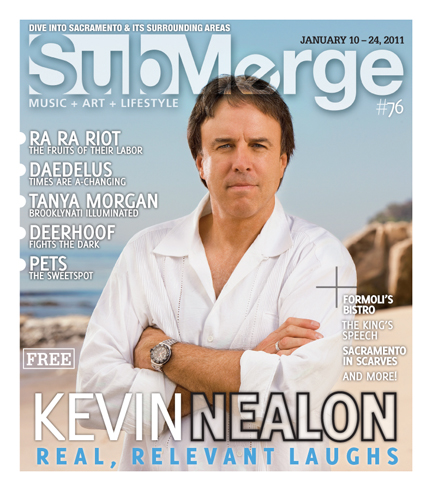
If you missed Kevin Nealon when he was in Sacramento you can see him on Feb. 26, 2011 at Montbleu in South Lake Tahoe.
Big-mountain snowboarding legend Jeremy Jones leaves snowmobiles and helicopters behind, opts to hike his lines instead
Truckee, Calif.-based professional snowboarder Jeremy Jones is changing the way the world looks at big-mountain riding. For years, Jones had been riding and filming in zones that can only be accessed via helicopters and snowmobiles, but all that changed when he decided to leave the motorized help behind (for the most part–there were some plane trips involved). He opted instead to venture into the mountains on foot in search of untouched terrain for his newest movie, Deeper, in conjunction with O’Neill and Teton Gravity Research. The documentary-esque film puts viewers in the athletes’ boots as Jones and a crew of the world’s top freeriders, including Travis Rice, Xavier De Le Rue, Josh Dirksen, Ryland Bell, Jonaven Moore, Forest Shearer and more, venture into the unknown in locations like Alaska, Antarctica, Europe, Utah and right here in California’s Sierra Nevadas. These men (more like machines) endure a multitude of extremes, including all-night hikes up their chosen lines, sleeping on top of peaks to hit said run at first light, camping on a glacier 65 miles from civilization for weeks on end, 20-below temperatures, 10-day snow storms and 20 mile days. “I’ve been snowboarding 25 years, and I don’t think that I’ve ever learned more and evolved more in a two-year period than these last two years,” Jones recently shared with Submerge from his home. “And it’s years 24 and 25! That pretty much sums up why snowboarding is such an amazing sport.”
Most of the evolution Jones speaks of came in his mountaineering skills; to simply call Jones a snowboarder would be a crime. The sheer magnitude of hiking, climbing and camping he is doing is on a whole other level than any other snowboarder or skier has ever achieved. Deeper was shot over two years and Jones says the progression, learning curve and overall dedication from the crew was drastically different from year one to year two. “For example, an early wake-up on the first year would be 5:30 a.m.,” Jones said of their morning hike start-times. “The second year was 2:30 a.m., you know, just realizing what it really takes to get the big lines.”
In the following interview, Jones chats with us about Deeper, hints at his plans for filming with Travis Rice this year as well as his rumored follow-ups to the film, and he even offers up advice for those looking to get out and explore the backcountry in the Lake Tahoe region.
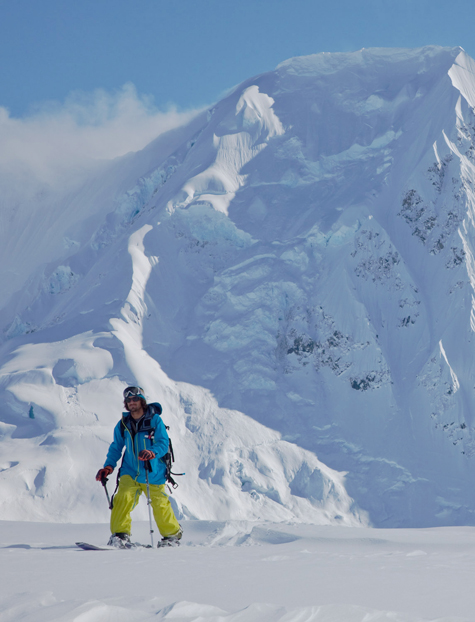
One of the first questions that came to mind when I watched Deeper was how many times you said, “I’ve never done anything like this before,” during the filming of this movie. That is pretty much what this movie is all about, isn’t it? The trek into the unknown…
Yeah, and I came up with that line, “A snowboard adventure into the unknown,” because every day, every trip, we were like, “Well let’s go see what we’re going to find out there and figure out how to do it.” It seemed like right up ‘til the end I was doing stuff I’d never done before. It was classic, because the last Deeper trip was in the High Sierra, and it was kind of a wind-down trip. We had a cameraman with us, but we were just like, “We’ll see how it is,” which is how a lot of these trips are. But it was funny because we were back home in spring, a pretty mellow deal compared to what we’d been dealing with, and right up until the last morning of filming I’m like doing stuff I’d never done before. It was endless the amount of times I said, “Never done that before!” What changed going into the mountains two years ago from how we go into the mountains now, it’s so drastic.
Fifteen years filming, 45-plus movie parts and you end up in a tent waiting out a 10-day storm on a glacier in Alaska 60-plus miles from any “town.” How rough was that? Had you ever been through anything like that before?
Well, it’s funny because I’ve been going to Alaska for five to eight weeks a year for 16 years and I had never seen a storm last that long and be that intense for that long. I was with Tom Burt also, who’s done even more time in Alaska, and we were just like, “There’s just no way it’s going to keep going. It’s got to end sometime.”
So every day you tell yourself, “It’s got to end sometime,” but at what point did you start asking yourself if you were crazy?
You know, day eight, day nine, day 10, you start going, “Was this a good idea? Is this feasible? Maybe we shouldn’t be doing this.” Then out of nowhere… It’s amazing, for how much weather forecasting that we have, it still comes down to, “Wake up and see.” In Cali, it’s way easier to predict… Then on day 12 we wake up, and it’s perfectly clear and then it’s on and after your first run you forget about the last 12 days.
On trips like that one where you’ve sort of rounded up a select crew and talked them into something so extreme: camping on a glacier, hiking massive faces, etc., do you feel responsible for them the whole time?
I don’t in the sense of like, if they get stuck in a tent for 10 days, then whatever, it’s part of the game. I do if someone ends up getting in a big avalanche or something, then for sure. But that trip, it’s funny because we went out thinking we were going to be out for five to 10 days, and then it turned into a 26-day trip. We realized once we got out there, “You know what, this is really hard.” It takes a whole day to move, there’s no going back into town for a storm and coming back out. We needed to live it.

When you’re standing on top of a line that you’ve been studying for weeks, maybe even months, and that you just hiked up with your own two feet, what’s going through your head right before you drop in?
It’s pretty much all joy. There’s total confidence, because at that point you’re standing on a line that you’ve looked at for so long and the fact that you were able to climb it, you’re super confident that the snow is safe. You know exactly where you’re going to go. Like the last line, “The Wall of Walls,” that I hit at the end of the second Alaska segment, I could look at that from my tent door. I had skinned underneath it. I had hiked and looked at it from every angle imaginable, I probably mind-surfed the thing a thousand times; when it was all said and done I probably stared at that thing for 40 hours. And then I’m on the top of pretty much the biggest line of my life, and it’s got full exposure and I don’t even need to look at a photo of this thing. I’m thinking, “I know every inch of this thing.”
In the Chamonix, France, segment there’s one line you guys end up stepping away from after multiple attempts, Aiguille Blanche de Peuterey. Is that something on your hit list still? When can fans expect to see you take that one down?
That thing is so rare to be in form, and we spent two weeks on it in prime season, made three attempts on it in a 10-year cycle. It hadn’t been that good in 10 years, and we came up short. And you know, those three attempts were full-on three-day attempts each of them; camping, hiking, all sorts of riffs going on getting to it. If the stars align perfectly and I’m back in Chamonix and the thing’s in form, then yeah, that thing will go down. I really have to plan a trip around it, because that stuff goes down at like middle to end of May. That one may not come back. It’s a very dirty line, there’s so much secondary exposure, and in general I really try and avoid that much secondary.
Switching gears a little, you’re big on sustainability and protecting the environment. Is it important to you to spread the message that splitboarding is a great way to get out and explore the backcountry without motorized help?
First and foremost that message is really important for people to realize that freeriding doesn’t require a huge wallet. There’s not a huge price tag. You know, 1 percent of snowboarders can afford to go to Alaska and go heli’ing.
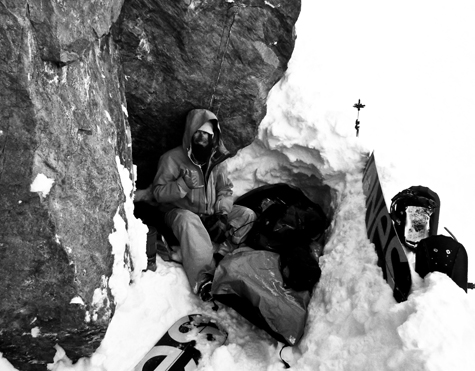
There’s a reason why we don’t ever really reference the environment in Deeper, because there’s a carbon footprint to that movie. It’s a lot smaller than other movies. It’s a sensitive subject, but the thing I can take away from Deeper is that people come out of it inspired, they want to get into the mountains, hopefully they get into the mountains and learn to love the mountains, and then they hopefully protect the mountains. That’s a really simple deal there; it’s also really powerful. That’s the thing, it’s more showing people, “Hey you can go freeride, it doesn’t matter how much money you have.”
Most of our readers are in the greater Sacramento area, so for someone who is new to splitboarding and/or backcountry riding and hiking, where would you suggest to start out? Are there intermediate spots?
Yeah, Mt. Rose! Or closer to you guys is ASI [Alpine Skills International], you know, Donner Summit. But the thing is, with this area, people need to realize that this is like one of the best places in the world. We get often times more snow than any place in the world, and we traditionally have the safest snow pack in the world, which is amazing. You need to get up to speed and stuff, but you can get up to speed a lot quicker in California than you can in say Colorado or Utah as far as like learning when the good days are.
Yeah, like the general rule in Cali is we have the “five red flags,” and one of the red flags is “90 percent of avalanches happen during or within 24 hours of a storm.” And with the 24 hour settlement rule, if you watch the Sierra Avalanche Center’s website with a daily forecast that goes live at 7 a.m. every morning, you’ll see it snow like 12 feet, then have one sunny day, and during that big storm the avalanche stability might be “extreme” or “high” or whatever, it’s dangerous. But just one day of sun and then you are dealing with low avalanche probabilities. Every day they issue a report if it’s low, moderate, considerable, high or extreme. Eighty percent of the time it’s low in California.
Which is just awesome for someone who is looking to get out and explore!
Yeah! The sled zones make up about 3 percent of the Sierra, so to really get out there you’ve got to do it on foot.
That’s such a crazy figure to me! The possibilities are endless for you now. When is the last time you hopped in a heli to hit a line?
It’s been two years.
When is the next time you see yourself hopping in a heli to hit a line?
I do have a trip with Travis Rice [for his newest project, Flight]. I’m still on the fence if I’m going to do it. But, you know, if special things like that come along…
It’s almost like you can’t say no to that.
I’m having a hard time saying no to it. But as far as like going back to my traditional program, those days are definitely over–as far as if I’m putting together on a trip, I’m not putting together heli trips. That’s a pretty unique opportunity in snowboarding, and it would take something like that. That’s something I’ve been very clear about is to never say, “I’m done with helis forever.” I’m sure the time will come, something like this Travis movie comes along, but it’s definitely not my focus.
I ride at Sierra-at-Tahoe and have heard a lot about the addition of Huckleberry Canyon to their ski boundaries a couple seasons back. You can access five gates from their main lift and they take tours and they’re educating people about backcountry skiing and riding and are incorporating it into the resort experience. Do you think more resorts should try and do something similar?
Absolutely, man! I’ve been lobbying hard to get some gates at Squaw. In this day and age for resorts to have closed boundaries seems criminal to me. It’s really cool; it’s a great trend. They’re even doing it on the East Coast now at a resort that I partially grew up riding, Sugarloaf [in Maine], they just doubled their acreage by opening up side-country. This peak right next to it that you have to hike to, it’s a perfect North facing aspect. It’s genius.
I read somewhere you’re doing two more films in the coming years, Further and Higher, as follow-ups to Deeper. Are those just ideas or what? What can you tell me about those projects?
They are solid ideas for sure. I’m still kind of digesting Deeper and seeing if the funding is out there and kind of kicking around and trying to figure out if I’m going to do this Travis Rice thing or not. But I’d like to think there’d be some more coming.
I’ll end with an easy one: Did you ever in your wildest dreams think snowboarding would take you this far?
I knew from an early age that I’d be living in the snow and snowboarding every day, and I always kind of had that pursuit to ride really good terrain. But no, when I started snowboarding there was no such thing as “pro snowboarders.” So no, I definitely have far surpassed my expectations. I feel very fortunate to be given the opportunity that I’ve had and also I realize how lucky I am and that’s why I take full advantage of it. There’s a lineup of people that would love this opportunity.
Grab a copy of Deeper at your local snowboard or ski shop or download it on iTunes. For more information or to view the trailer, visit www.tetongravity.com/deeper

Torstein Horgmo has pushed the envelope
On Saturday, June 5, in the dead of summer on a glacier in Norway, 23-year-old professional snowboarder Torstein Horgmo changed the sport forever when he landed the first-ever triple cork caught on film. That’s three off-axis rotations, or diagonal flips, if you will, completed in one huge-ass jump. Two days later, Horgmo uploaded a minute-long clip featuring the gravity-defying trick to his website (www.torstein.net) and to his Vimeo page, and within hours the video had gone viral, sending a shockwave through the industry that left jaws on the floor all around the world. The same day the video was uploaded, Snowboard-mag.com posted a link suggesting that the trick be called “the Cosmonaut,” because, “Homeboy looks like he’s in one of those anti-gravity planes.” The next day, Espn.go.com said, “Everyone knew it was just a matter of time, but how many guessed we’d see it this season? Or, for that matter, on the Internet first?” This brings up a good point: traditionally, riders and film producers save the biggest and best tricks for their video parts that premier in the fall, but Horgmo has embraced the power of the Internet. “I just wanted to put it on my website; I thought that would be cool,” Horgmo recently shared with Submerge. “It’s a little unusual, people usually put all their bangers in their video part, and I have it in my video part too. We had so many angles of the trick and after all that effort I kind of just wanted to get it out right away.”
He added, “I didn’t expect it to be that big. That was crazy.”
The video part Horgmo refers to is in The Storming, the newest offering from Tahoe-based snowboard film pioneers Standard Films. Horgmo’s part features multiple camera angles of the triple cork, so don’t fret if the one-minute clip available online now has left you hungry to see more. The highly anticipated film will see its Sacramento-area premier on Saturday, Oct. 16, 2010 when Ground Zero Board Shop will host a giant premier party at Barcode with live music, giveaways and more. In the following interview, Horgmo chats with Submerge about landing the now infamous triple cork (on a bum ankle, mind you!), what it’s been like working with Standard Films on The Storming and other flicks, a nearly career-ending injury he sustained a few years ago, as well as his thoughts on the current state of the snowboarding industry.

So we’ve just got to talk about this, I’m sure everyone in the world wants to talk to you about this: the triple cork! That trick is mind blowing. Tell me about it, how did it feel to ride away from it?
I was in a lot of pain, so once I landed I didn’t really have any pain anymore, you know? I just wanted to get it out of the way. I was so happy that the pain was just overwhelmed. Everyone that was there was super stoked; the vibe that was in the air was…I don’t know how to explain it. It was just a crazy day.
Had you tried it a lot before landing it?
It was just like one session during the day. The glacier was open, the lift was running and stuff, so we just kind of set up the jump and had that closed off. The jump was so high-speed we didn’t want people to get hurt coming in from the side or anything. We just started the session, and I was feeling the jump a lot, so I just kind of decided to go for it until I landed it. It was only a couple hours, you know, between setting up the jump, warming up with some mellow tricks, like I did a couple double corks, and I just wanted to get it out of the way after that. I think I gave it six tries, and then landed it on the seventh.
That’s a lot mellower than I had imagined. I was thinking it was this big hyped-up type of thing that took days to set up.
I didn’t want anybody to know about it. I just told the filmer that I wanted to try it, so we figured out the jump, figured it was going to be perfect for something like that to be tried on, you know? I just drove down with him, the main filmer, he’s a skier/filmer and had a skier crew on the jump and none of them knew I wanted to try it either until that day. I didn’t want any hype to get out there or whatever.
I want to talk about The Storming. Are you stoked on how your part turned out?
Yeah for sure. Out of the time I had on my hands with the season and what I had time to shoot, I’m super happy about how it came together. Luckily I ended up with a lot of shots that I wanted and a lot of sessions came together randomly so I got some stuff I didn’t plan, too. I’m really happy with how it came together; I’m super into being a part of how the shot order comes together and stuff, too, so luckily I got to work a little with Travis [Robb, filmer] in Squamish [British Columbia, Canada], that was fun too.
How do you like working with Standard Films?
This is the third film with them. I love working with those guys. I’ve learned so much over the last three years. Those guys are triple OGs in the backcountry. They just take me to all these sick spots and show me some amazing snowboarding. Just thinking about all the movies they’ve made and all the legendary riders who have filmed for Standard before. Being a part of the new generation over there has been sick.
What’s it like going back and forth between riding in contests and filming for video parts all year? Do they feed off each other or take from one another?
I think they definitely help each other out. If I’m out filming one week and just focusing on getting the stuff I want on all the spots properly, getting them just right, having long sessions with good friends, it’s a little bit mellower. Going from that into a contest maybe helps you not stress out too much on the contest scene and definitely helps your style a little bit too. Going from a contest week into filming again, the tricks you have in a contest like in a slope-style run, if you want those tricks in your video part, you’re definitely more prepared going into the backcountry with how those tricks are feeling, you know, and it helps decrease the amount of tries you spend getting a shot.
That’s interesting to hear that, because I feel like a lot of snowboarders are like “fuck the contests, I’m all about the free riding,” and some riders are the other way.
That’s right what you’re saying. They’re two completely different scenes. A lot of riders at contests, they just do contests and they have a different mentality. Some of the things they do and how they act, I can feed off that in both worlds–other stuff I’ll be avoiding. I still snowboard to progress myself. That’s always been the funnest part of snowboarding to me is learning new tricks, like when I was a kid and I would learn something new every time I snowboarded. Every time I was at a contest I pretty much learned a new trick and progressed myself. But, you know, I wouldn’t have started snowboarding or pushed to have made it to where I am today if it wasn’t for the inspiration I got from the snowboarding videos, too. It’s been a huge goal for me to be able to film video parts as well, so I just want to keep doing both.
I read somewhere that a few years ago you broke your back at a contest! What happened there?
It was just super shitty weather. I showed up a little late to a contest and didn’t have any practice time. The day of the practice was the day of the qualification. I was just coming out of the holidays. I was stressing a little bit about figuring out what I wanted to do on the run, and we only got minutes to ride on the course. It was foggy and windy. I couldn’t see shit. They almost considered blowing the whole thing over, calling it off, but they kept running the practice. They had four jumps in a row and on the fourth jump I got a gust of wind or something and all of a sudden had super speed and went way too far and overshot the jump. I landed on my butt and bounced around like crazy and that was it.
That must have been depressing for a young, up-and-coming athlete to all of a sudden be in that situation where you can’t perform. Did you think you’d be snowboarding again so quickly? Because you were back on your board in a matter of months, right?
Yeah, I just didn’t really think too much about it. I didn’t need surgery, I knew that. When I got back home to Norway I talked to athlete doctors, or specialists or whatever, and they told me that it was just going to take time but I was going to be fine. I was like, “There’s no way! I am coming back from this. I am going to be snowboarding again real fucking soon.” There was no way that was going to set me back. I think that helped a lot, thinking like that all the way through.
What’s your take on the current state of the snowboarding industry? With guys like Shaun White taking it so far into the mainstream, the sport has more spotlights on it now than ever. Do you think it’s a good thing for the sport?
That’s just naturally happening, and I’m trying to evolve myself with it, you know? I think it’s kind of exciting. There’s always some stuff that’s going to be shitty, but there’s a lot of good things coming out of it too. With more corporate stuff happening, there’s more money involved to put on bigger and better events, and we can see sick movies like Travis Rice’s movie That’s It, That’s All, I don’t think that would have happened if the sport wasn’t growing so fast.
How many riders do you think are out there trying to learn triple corks into a foam pit somewhere?
[Laughs] I don’t know, dude. I don’t really know how foam pits work.
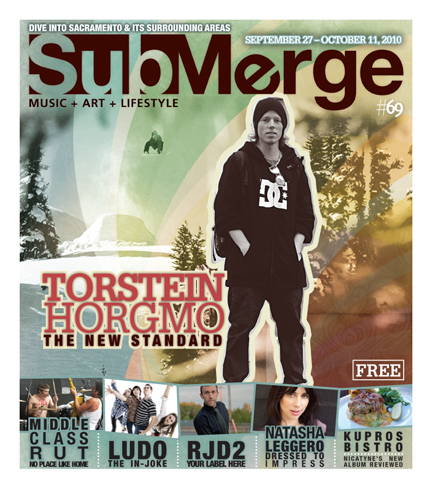
Don’t miss the premier of The Storming feat. riding from Torstein Horgmo and a slew of other amazing snowboarders on Oct. 16, 2010 at Barcode. Doors open at 6 p.m. and tickets are $13 in advance (available at all Ground Zero locations) and $15 the day of. Admission comes with a free lift ticket to Sierra-at-Tahoe or Northstar-at-Tahoe. All ages are welcome.
Smashing Pumpkins
Crest Theatre, Sacramento, Calif.
Monday, Sept. 6, 2010
At 7:30 p.m. the corner of 10th and K streets was littered with hundreds of Smashing Pumpkins fans waiting in line to see Billy Corgan and crew in one of Sacramento’s most beautiful venues, the historic Crest Theatre. As fans poured into the building (and especially into the beer garden), Chicago’s Bad City attempted to get the crowd ignited with their ‘80s hair-metal influenced tunes. SPIN.com called them “a modern day Whitesnake,” and I’d say that’s a pretty spot-on description.
At 9:01 p.m. the lights dimmed and the crowd roared as Corgan and his current lineup, which includes 20-year-old drumming prodigy Mike Byrne, lead guitarist Jeff Schroeder and bassist Nicole Fiorentino, took the stage. The first song they dove into was “Astral Planes,” a newer song from Teargarden by Kaleidyscope, where Corgan sings “Everyone gather, warm your soul,” on top of a grungy, slightly Fuguzi-esque guitar riff. Indeed, everyone had gathered; and rest assured our souls were warming, as did the energy in the room. The song “1979” off the nine-times-platinum album Mellon Collie and the Infinite Sadness had the crowd reciting every lyric back at Corgan, as did songs like “Bullet with Butterfly Wings,” and “Tonight, Tonight,” which sounded fantastic despite the apparent lack of a string section like on the original recording. In the same manner, the song “Eye,” released on the Lost Highway soundtrack in 1996, which is very electronica, translated great into this guitar-driven performance with live drums. Speaking of drums, it needs to be noted that Byrne was an absolute beast all night and at one point soloed for a solid four minutes onstage by himself and left any drummers in the crowd wanting to quit immediately.
At one point about midway through the show, an acoustic guitar was brought out for a change of pace. Corgan even played ukulele on one song. With the change in pace came the first real crowd interaction on Corgan’s behalf. He mentioned how in his hotel room there was a copy of Sactown Magazine. “Sactown!” Corgan yelled. “Isn’t that what they call it?” He poked fun at the term “Sactown” a little more and muttered that maybe it wasn’t a good term to use if our town was looking to attract tourists. People laughed. He also thanked those in the front row who were smoking pot. People laughed more. It was refreshing to see Corgan, now 43 years old, having a little fun with the crowd. After an epic encore, the band left the stage to screeching feedback, waving to the crowd while throwing picks and drumsticks along the way.
At 11 p.m. the crowd was pouring out of the theater, electrified. Every one of us knew we had witnessed something special, something to brag about. It’s not every day Billy Corgan is in town.
Deftones are back at the top of their game
Sacramento’s own marquis band, Deftones, have come quite a way since their inception in the late ‘80s. From gigs at backyard barbecues to sold-out shows at the Cattle Club, to landing a record deal and headlining huge tours all around the world in support of chart-topping, genre-busting albums, these guys have been through thick and thin and have maintained momentum, as well as a rabid fan base, along the way. During a recent interview with Submerge, drummer Abe Cunningham reminisced on the old days. “We’ve surpassed any expectations,” he said with a chuckle. “We wanted to play the Crest Theatre; that was the huge goal.” After agreeing that they’ve achieved that goal and then some, he went on to say, “Every day from this point on, not to be corny, is a blessing. We’ve been so wild over the years and just fucked off so much and just been out of our minds fucked up on everything, just having the rock ‘n’ roll time of our lives. And I’m not saying that we’re angels now, we certainly have a blast to this day, but we’ve chilled out a bit.”
Unfortunately, Deftones original bass player Chi Cheng remains in a semi-conscious state after a horrific car accident in early November 2008 left him in a coma. This near loss of a friend and band mate quite obviously sent a shockwave through the group, who at the time was done with a record called Eros. After much deliberation, the band ultimately decided to put the release of Eros on hold and quickly got back to doing what they do best: making music. They enlisted longtime friend and former Quicksand bassist Sergio Vega to fill in as Chi slowly recovers. As the group began gathering at their West Sacramento rehearsal spot, it was quickly evident that they were all itching to create again, despite having just shelved an entire record that they poured themselves into for over a year. Before they knew it, the band had an entire new album’s worth of material. That material, born of tragedy and heartbreak, became the band’s sixth studio release called Diamond Eyes. The album charted at No. 6 on the U.S. Billboard 200 in May of this year and is arguably some of the band’s best material to date. “We’re better now than we’ve ever been,” Cunningham said with confidence.
In the following interview, Cunningham chats about their new record, Cheng’s current status, the band’s new lineup and more.
I’m curious, who in the band still calls Sacramento home?
Stephan [Carpenter], our guitarist, he moved down to the Los Angeles area a while ago. Chino [Moreno, vocals] lives in the L.A. area too. He moved down there maybe about three or four years ago. Frank [Delgado, keyboardist] and I are still here, and Chi is here. Sergio, our buddy who is playing bass with us is from New York. But I mean, we’re still a Sacramento band, we still claim it.
That’s cool because you guys have become such an international force over the years. It’s nice to see you still claim Sacramento. I feel like some bands that blow up from here end up claiming the Bay Area or L.A. or something.
I am sporting a Giants hat, but hey, you know? [Laughs] I mean shit, it’s where we’re from. Everybody’s from somewhere. And it’s not even that bad, so what the fuck, you know?
How is it performing the material off of Diamond Eyes? The record was conceived, produced and released in a very timely fashion, how does that affect the way the songs are translated in the live setting?
I mean everything is new still; the songs are still all very new. This is really the first record that we went in [to the studio] with the material all done since probably Around the Fur, actually really since our first record. Since then, we’ve mostly written everything in the studio, which can be really cool, but it also can be just fucking crazy because it’s super expensive and if you’re not gelling and getting shit done, it can just be insane. It can be a really costly, mentally draining experience all around. So that’s the way it’s kind of been for the past four records, at least up until this one. We just went in and blasted it out. We wrote it so quick and had a blast doing it despite everything that had been going on with Chi. It was a catalyst for us getting down to it.
So it was a more organic approach than you took with previous albums in that you guys were able to completely play all of these songs live in your rehearsal room before ever hitting record, right?
Yeah, dude! We can’t even play some of the songs on some of our records [laughs]. We’re actually like, “Wow, we’re a real band again. We can play our own shit.” Not that we couldn’t play all our other shit. In the studio we’ve never tried to do anything so outlandish that we could never really perform it live. Studios are great for that. You can get down and you can make the most insane masterpiece, but can you pull it off live? That’s why we always tried to limit ourselves a bit, because we’ve always wanted to be able to do it live. This time around we just blasted it out and had a great time doing it.
If you don’t mind, I’m sure it’s a touchy subject, but I’d like to talk briefly about Chi and that whole situation. When’s the last time you saw him?
Chino and I went down right around Easter; we were taking off for tour for quite some time. He’s back down in Stockton.
So he’s at home now, not in a hospital, right?
Yeah, he’s been home for a while. It’s way better than being in a hospital somewhere.
How is he doing? I read on www.oneloveforchi.com that he is undergoing some crazy “wake up protocol” and being looked after by top-notch doctors. What can you tell me about that?
These doctors that took him on are apparently involved with a lot of people coming back from the Iraq war and Afghanistan. There’s been a skyrocketing number of people coming back with traumatic brain injuries–roadside explosions and shit like that. Anyway, these doctors I guess have had tremendous success with people that are in exact or similar states that Chi is in, bringing them back to some degree. Because, I mean, he’s awake, he’s there, but he’s trapped. It’s kind of like the Metallica “One” video.
I just got the goose bumps, because I was thinking the exact same thing. It seems like he’s come a long way already, though, like his eyes are open now and he looks more aware and you can talk to him and he engages, right? How encouraging is that, being one of his closes friends and band mates?
All I want is the best for him, man. I think about his son, he’s got a son. I think about his whole family obviously, but he’s got a 12-year-old son who’s just the raddest kid and that’s really on my mind. He needs his dad back. Fuck him playing in the band again, that would be awesome if that could happen, but…
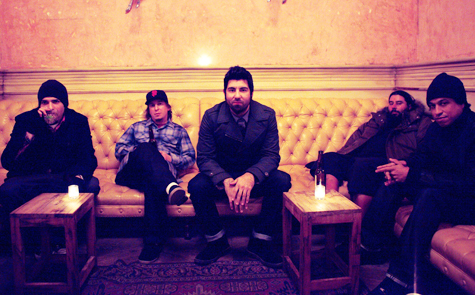
When it came time to make the call to bring in Sergio on bass and to continue playing and writing music without Chi, was that a tough decision?
I mean not really, and I don’t mean to be insensitive. Obviously we took time off to just try and figure what the fuck we were going to do and why this happened, and you just realize that some things you can never ever no matter how hard you try find an answer for, and this is one of them. Well, I’ll tell you why it happened; he wasn’t wearing his fucking seatbelt. So, of course we were trying to figure out what’s up with the band, and we took a couple months just to breathe and figure some stuff out. We just said, “Shit, this is what we do, we play music, we make music and we play it. We’ve been doing it for a long time now and it’s really what we do.” It was as simple as that. It’s what we do.
Was everybody in the band on the same page or was there some struggle between members?
Well yeah, it eventually came back to that struggle. At first Stephan wanted to just like start over again with a new band and all this stuff. Hey, I can dig that but come on, you know? Everyone was just kind of juggling ideas around, and it just came down really to getting back into our little spot out in West Sacramento. We have this studio we’ve had out there for a really long time. We just wanted to get out there, and we started jamming again, just for the sake of playing music. We actually had a record pretty much done called Eros. We’d been working on that for over a year already, and that was pretty much done. The whole thing with Sergio is, we had a show booked and we had this one thing we needed to fill, this one obligation. He had played with us before, he’d filled in for Chi way back, but he also came from this band Quicksand that we loved and was totally a huge influence on us, so we were all buddies over the years.
Was there ever anyone else in the running or was it Sergio all the way?
Yeah, it was kind of funny. He’s all neurotic, all New Yorker and shit. He came out here and I think he thought in his mind there was going to be 50 or 100 people in line to try out like that Metallica movie. He came out and he was all nervous, and we were like, “Dude just come out here, fuck this, come kick it.” We kind of shot the shit for a little bit and in actuality we were like, “Dude, you’re the only person we had in mind. There was nobody else.” He was just like, “Phew” and took a deep breath.
Can you tell me a little about the decision to put Eros on hold and start the writing process all over again for what would become Diamond Eyes?
It was really a huge decision for us. When it was brought up, I was like, “Yeah, I’m down,” when inside I was like “Fuck, I really don’t know.” I knew we could do it, but I had some reservations. We had just done this Eros thing. We were totally tapped creatively and all this shit. I was like, “We can do it! But wait, can we really do it?” But everything just came, you know? And with Eros, honestly, if we would have put that record out right now, it just was not the right time for that record. It’s not that it’s bad, there’s some good stuff on it; it just wouldn’t be good for us, man. And really it was out of respect for Chi, too. We spent all this time writing and recording and making these songs with him, and for us to go out on tour with those songs without him would be a trip. We just said, “Fuck it, let’s not shelve it, let’s put it on simmer on the backburner and let it chill a while and Chi, hopefully he can join us.”
You worked with a new producer on this one, Nick Raskulinecz. How much of an influence did he have on this record? Was he there during a lot of the writing?
Oh yeah, he was in there every single day with us from the get-go until we finished the record.
Was that new for the band, to sort of have that outside influence when crafting a record? Have you ever let anyone in creatively like that?
Never. We did most of our records with Terry Date, who is a dear friend. He’s a producer, but he’s more of an engineer. If he had an opinion, of course he’d say it, but he never was hands-on up in our shit. Normally we don’t like that shit, we’re like, “Fuck man, we can do this. We’re doing OK, leave us alone,” but Nick is just a rad dude and is so much fun to be around. He was right up in there with us. Everyone totally gelled and trusted him. Our biggest hang up is we’ll be jamming for hours and hours and hours and have cool shit come out, but nobody will ever stop and say, “That was tight, do that.” What he did was just float around the room and encouraged us to do what we were already doing. He just made everyone confident, like, “Wait, I’m doing rad shit, cool!” It was like fire, man.
It seems like everything was in place, you know? Nick was a fan of the band and on board to produce, Sergio came out and fit right in, you all started creating music again together in your old band room. It’s pretty uplifting, and frankly I think Chi would be pretty proud.
That’s our whole goal; there will always be some people that don’t get it. They ask, “How could you? How dare you?” You know what, fuck you, you have no idea how this works. You can sit on your keyboard on the Internet and talk shit. It’s really not been like that though. For the most part everyone’s been very supportive. We’re out doing our thing in Chi’s name, in his honor. He’s right there with us in spirit. I know he’s around.
Arden Park Roots are at home on the road
The road is fuckin’ rough. Ask any DIY touring musicians and they’ll likely confirm this. Long drives, sketchy venues, snakey promoters trying to screw you out of gas money, pissing in water bottles while driving the van and then the van breaks down–it’s not a glamorous life by any means, and Sacramento’s reggae/rock group Arden Park Roots know this from first-hand experience. The local foursome, consisting of vocalist/guitarist Tyler Campbell, lead guitarist Nick Ledoux (aka “El Guapo”), bassist Spencer Murphy and drummer Jonny Snickerpippitz, have become road warriors, logging thousands of miles over the past couple years both in support of their self-released 2008 full-length album The Hard Way and as their alter-ego Sublime tribute band, The Livin’s Easy.
On one recent tour, the guys had a couple days off between Colorado and Arizona and decided to do some sightseeing. During a recent interview with Submerge, Jonny remembers, “We were like, ‘You know what? The Grand Canyon is right over there,’ so we started busting over that way.” Not long after, their vehicle overheated, forcing the guys to pull over to allow it to cool. Jonny, not being the type of guy who’ll just sit and wait for a vehicle to cool down, decided to charge up a mountain on the side of the highway. A little side-of-the-road hike, if you will. “There was just this huge mountain next to us,” says Jonny. “I was like, ‘This is kind of cool,’ so I started running up it and all of a sudden I heard, ‘Dude, Jonny, stop! You’re up too far.’” Meanwhile, Campbell and the rest of the crew were down below, looking up at Jonny climbing a mountain, laughing at him while filming his shenanigans on their cell phones. It was about this time when things went downhill fast for Jonny, literally.
“I looked back down and thought, ‘Hey, I’m going to dazzle the guys and just run all the way down,’” he remembers. “I missed about the last 20 feet and just shattered my ankle. I crawled up onto the highway, rolled onto my back and my foot flopped one way, rolled over the other way and my ankle flopped back, it was obviously offset.”
Ouch! A drummer with a broken ankle would have abruptly ended the tour for most bands, but not APR. They got Jonny to a hospital that night, where they reset his foot and told him he’d need reconstructive surgery. The timeline for the next couple days went a little something like this: Monday night, Jonny checked in, Tuesday he had surgery, Thursday evening he was released and Thursday night he played a “painful” gig. What a savage!
Jonny and Tyler Campbell stress how cool the venue in Flagstaff, Ariz., was with the whole situation. Campbell remembers rushing there first thing Tuesday morning after crashing in a hotel the night before (Jonny was in a hospital bed of course) and explaining to them what happened. “They were like, ‘Dude, it’s cool. You guys can stay in our apartment while you’re here.’ So they housed us for three whole nights. Meanwhile, I’m showing them the video on my cell phone,” Campbell says with a good laugh, “So they knew it was legit.” The understanding staff from the venue even called up a bunch of local musicians to come in and jam on APR’s equipment that night. Campbell remembers the good vibes well. “So the night we actually played, it was this big musician forum and a really cool, touching, ‘town come together’ type of night.” Luckily, that was the last scheduled night on the tour, so APR headed home with both Jonny’s ankle and their spirits elevated.
Turns out, APR is used to this kind of warm and welcoming reception when on the road. As our conversation turns toward which random markets around the country they do well in, it suddenly becomes clear why these guys love touring so much.
“The Midwest man, they just like fucking California bands and they love reggae music,” Campbell says. “Rapid City, S.D., is our best town on the road, I don’t know why.” Jonny interrupts with, “We sell out every time. We usually play there two nights in a row.”
If this is not enough proof that APR is the ultimate party band, said venue in Rapid City quite literally ran out of liquor by the end of the night after APR had played their three-hour set (half originals, half Sublime tribute). “They had nothing,” jokes Campbell. “Literally by the end of the night they ran out of liquor. They were like, ‘Do you want a Corona, because that’s all we have.’” The two also point to Durango, Colo., as another one of their favorite random towns to play. There’s a neat old theater that has been pimped out with a top-notch sound system complete with four audio guys to assist APR in sounding as good as possible. But the steakhouse down the street where they get treated to five-course meals is just as big of a draw.
“That’s why we spend so much time in the Midwest,” says Campbell. ”They fucking feed us, they house us and they fill up the clubs. A nice meal out on the road is heaven.”
Currently Arden Park Roots are home, eagerly awaiting the release of their second full-length album, No Regrets in the Garden of Weeden, which was recorded over the winter at Pus Cavern just before the group left on the infamous ankle-shattering tour. No Regrets…, which is a huge leap forward for the band as far as diversity in sound goes, will be released on July 9, 2010 at Harlow’s. Fourteen songs made the final cut, with a good number of tracks getting the axe, not because they were B-side material, but because APR was confident they already had enough songs for it to be a solid album with “no skippers,” as Campbell puts it. That extra material will be used for the band’s third album, which the two agree is already about halfway done. One track from No Regrets… that kept coming up during our conversation was “What You Got to Lose,” which, with its haunting vocal melodies and hybrid electronic/dub/reggae-rock vibe, is Campbell’s favorite.
“I can listen to that song and not think about myself,” he says. “Which is weird because every song I hear of myself, I just analyze my performance. With this song I can just sit back and listen to it and go, ‘Now that’s a good fucking song.’”
“What You Got to Lose” is a perfect example of just how much APR branched out on No Regrets…. While in the studio, the band left no idea unexplored; they experimented with new instruments, layered sounds and most importantly they learned that one of the most important aspects of making an album is allowing the engineer to do his job, to give him the time and space necessary to do what he does best. “We didn’t have a blank check,” says Campbell, “But we had a budget that was comfortable. We were able to go in and not worry about time.” For that reason, Pus Cavern’s Joe Johnston was able to take his time when engineering the record–and it really shows in the final product. No Regrets… is polished but not over-produced; it’s a leap forward for APR, no doubt, but not so much that it leaves their old fans behind. They still rock, they can still bring the party; they just do it with a little more class. “When it comes to vocals,” Jonny says of Campbell’s performances on No Regrets…, “You can tell we’ve been out on the road quite a bit between the first and second albums. He can do more stuff now. He’s got a gorgeous voice, man. You can hear stuff that he does differently, more maturely.”
As Jonny’s foot slowly heals (he was still on crutches at the time of our interview), the group is realizing that this downtime in between releasing No Regrets… and hitting the road again isn’t such a bad thing. Campbell sums it up best when he says, “On the bright side, with this ankle injury we’ve had some time to recollect ourselves and really get hungry again.” With a new album and an insatiable appetite to hit the road again, Arden Park Roots are looking forward to finishing 2010 on a high note doing what they do best: working hard. “You can’t expect opportunities to be handed to you,” says Campbell, “You’ve got to cover your own ass.”

Arden Park Roots will celebrate the release of No Regrets in the Garden of Weeden on July 9 at Harlow’s and yes, Jonny Snickerpippitz will be healed enough to play. The album will be available through all digital outlets, at all Dimple locations and at shows.
Circa Survive branches out on Blue Sky Noise
When Philadelphia-based rock band Circa Survive began writing in late 2008 for what would become their third full-length album, the group was at a rather uncertain point in their career. Not only had their contract with longtime allies Equal Vision Records come to an end, but the group would also undergo a management change, further adding to their incalculable future. “There was this time where literally we were just floating in space writing songs for a record and had no idea where it would land,” remembered guitarist Colin Frangicetto of the unsettling feeling. “There was a huge question mark hanging over everybody’s head,” he said.
That question mark would hover for a lot longer than Circa Survive expected as the process of finding a new label to call home dragged on and on. “We just thought we would go meet with some people, take a couple of weeks to figure it out and sign, and it’d be over with,” said Frangicetto. Months passed and still no deal had been inked–all the while, that question mark was growing in size and weighing heavy on their shoulders, adding to the already intense amount of pressure that the band members had put on themselves to create a record they were truly proud of. Anthony Green, the band’s illustrious lead singer, was particularly overwhelmed and frustrated from trying to live up to his own expectations and had a complete mental breakdown halfway through the writing process. “He saw himself teetering off and kind of losing his grip on his own sanity and he just kind of needed to take a break,” admitted Frangicetto. With the support of his friends, family and band mates, Green checked himself into a mental hospital where he spent some time regrouping his thoughts and sense of balance.
“He’s a unique spirit, and as far as this kind of stuff goes he’s very sensitive,” explained Frangicetto. “It just wasn’t a huge shock that he needed to go somewhere and get help. I’ve felt myself close to that point, so it wasn’t this horrible thing where I was like, ‘Oh fuck, he’s going to quit the band.’”
When Green returned from his time away, regrouped and ready to jump back into the creative process, the band continued writing music together every day in a cottage-like house that bordered a stream and a nature preserve that they called “The Creek House.” They explored avenues of songwriting they never had before, searching for a perfect formula. For the first time in the history of the band, members other than Green contributed lyrics and vocal melodies on Blue Sky Noise; Frangicetto contributed to “I Felt Free” and “Imaginary Enemy,” and guitarist Brendan Ekstrom collaborated on “Frozen Creek” and the album’s first single, “Get Out.”
“I’ve always written songs but nothing that I would ever try to make a Circa song,” Frangiecetto said. “Then I just had a couple things pop out of me when Anthony was away that I really thought I could hear him singing. When he came back, I presented the songs to him, and he was just in love with two of the ideas.”
This new collaborative and communicative approach was revolutionary for the band and helped them achieve their goal of creating a completely different record than their previous releases, 2005’s Juturna and 2007’s On Letting Go, both of which were produced by the same engineer, Brian McTernan. Frangicetto pointed out that Circa Survive’s past efforts are much less dynamic than Blue Sky Noise, having been comprised mostly of intense songs with dual lead guitars, soaring vocals and pounding rhythms. “We listen back to On Letting Go and Juturna and it takes 50 minutes before you have a breath,” said Frangicetto.
So for Blue Sky Noise, Circa Survive enlisted some new help, three-time Grammy winning producer David Bottrill (Tool, Muse, King Crimson) and mixer Rich Costey (Interpol, Mars Volta, Rage Against the Machine), and decided to include some new elements that they’d always wanted to in order to attain an entirely new sound: a broader vocal range for Green to explore; plenty of acoustic guitars to provide space and quieter, more intimate dynamics; slide guitar to give a twangy, organic feel and upbeat rhythms to put off more pop sensibility.
“We wanted to make a progressive record, but at the end of the day, at least for me, art is about communication,” said Frangicetto. “When you’re making a super progressive record and you’re not making any attempt to really communicate, it’s basically like talking through a wall. You’re basically like, ‘All right, you’re going to pick up on some of the shit that I’m saying, but I really don’t care if you hear me or not.’”
With Blue Sky Noise, Circa Survive strived to knock that wall down and speak directly to people. In doing so, the band created a cohesive, dynamic record that when listened to in its entirety feels like reading a book; everything has been meticulously planned out and is in its right place, creating a seamless flow from start to finish. “The art of the record is dying and we’re aware of it,” said Frangicetto. “But we knew that right now we still had the chance to make a cohesive front-to-back album that you can listen to the way that we listened to our favorite records as kids.”
Blue Sky Noise was released on April 20 on Atlantic Records, making this Circa Survive’s major label debut. With the support of a global company comes larger opportunities; for example, when Submerge spoke to Frangicetto, he and the rest of the band were in the United Kingdom playing a string of three free shows just because they could, and another paid one in Germany because they had never been there. The band also recently made their national television debut on Last Call with Carson Daly and they’re currently on tour with Coheed and Cambria; all of these are massive milestones in Circa Survive’s career no doubt, but not all the credit should go to the fact that they are now on a major label, said Frangicetto. “We talk to our label, our manager, and people that are working for us and they are just like, ‘This record makes our job a million times easier.’ So I guess the question really becomes, is it the label or is it the record?”

Catch Circa Survive performing material off Blue Sky Noise along with some older tunes at the University Union Ballroom at Sacramento State on Thursday, May 6 (sans Coheed and Cambria). The show starts at 7:30 p.m. and is $10 for students and $15 general admission.
One of the biggest rock bands from down under comes to Sacramento
When rock band Karnivool from Perth, Western Australia, released their sophomore album Sound Awake in June 2009, the record skyrocketed to No. 2 on the ARIA (Australian Recording Industry Association) Charts. It sat just behind Black Eyed Peas’ The E.N.D. and solidified Karnivool as one of Australia’s biggest bands. “That was something I don’t think any of us could have really saw coming,” explained lead singer Ian Kenny during a recent phone conversation with Submerge. “I don’t think we’d ever envisioned seeing that on paper—us behind the Black Eyed Peas.” It must have been an odd thing to see, no doubt, considering that Karnivool’s blend of eclectic, progressive hard rock is a far cry from the club-bangin’ single-driven, vocoder-riddled music of Black Eyed Peas.
Karnivool should be used to the recognition, though. After releasing their full-length debut, Themata, in 2005, the band won five Western Australia Music Industry awards (commonly referred to as WAMi awards) in 2007, earning Most Popular Act, Best Hard Rock Act, Most Popular Live Act, Best Male Vocalist and Best Guitarist. “We don’t really give a shit too much about those things,” Kenny said of winning awards, “But the WAMis, that was kind of a big deal for us. It was a bit of a low-key event, but it was, you know, a lot of industry people and public people from our town, so it was a big deal for us.”
Since the release of Sound Awake, Karnivool has been busy touring in support of the new record, having recently completed a few-week-long headlining stint through the United Kingdom and Europe and a massive seven-day festival tour throughout Australia called Big Day Out, where they played to 50,000 people per day in huge stadiums alongside bands like Muse, Mars Volta, Mastodon and many others. When Submerge caught up with Kenny, he and the rest of Karnivool were at the South By Southwest Music Festival in Austin, Texas, where the band was set to perform multiple times. Their shows at SXSW will be followed by an impressive tour through the United States, which will bring them to the Boardwalk on Friday, April 16. It’d be wise not to miss these guys. There’s a reason why they are one of the biggest rock bands in their home country.
How’s SXSW treating you so far?
Austin is awesome, man. We’re smack bang in the middle of SXSW. It’s a musical soup. It’s a musical zoo, is what it is.
What’s your show schedule like? I know a lot of bands that play SXSW cram as much as they can into a couple of days.
Yeah, tomorrow is pretty crazy. We’ve already had like, I think, two acoustic shows and two electric shows. Tomorrow we’ve got two electric shows and one acoustic show, plus we’ve got a bunch of press in between all these.
You’re stacked with interviews, huh?
Yeah man, it’s crazy.
It’s probably because people are as hyped on the new record as I am.
You know what, I think they are! It wasn’t on my radar. Honestly I don’t pay too much attention, but people are kind of talking about this record and there were definitely a lot of people waiting to see the band when we got here.
Is it weird to go from sold-out club shows and huge festivals in your home country to smaller clubs here in the States?
I think the whole band actually digs that side of what’s happening right now. We really do. We get to come and sort of earn it again by playing these intimate club shows where people are right in front of you. Some people have never even heard of you, so it’s really cool to see people’s faces; you can gauge their honest reactions.
Your live shows definitely do the recordings justice. It’s too common for such “progressive” bands to disappoint fans in the live setting. Is that something Karnivool strives for, maintaining that polished studio sound even in the live setting?
I think it just comes down to the players, you know? Sometimes we completely fuck things up [laughs]. It comes down to the players. These dudes, all the guys in the band, they are just freak players, so they very rarely, once in a blue moon have a show that isn’t great. They are a bunch of freaks when it comes down to playing, and I think that’s how we pull it off live.
A lot of your songs contain complicated time signatures, but you seem to do it in a way where songs don’t lose their groove. Can you talk a little about being mathy and progressive yet still attainable for most listeners?
I think the thing that we find attractive, when talking about groove, is you want to find something that’s a little bit challenging and a little bit different. You kind of want it to pull and push things around. If you do it right, and that doesn’t mean you have to work that hard at it, but you just have to find that groove. At the end of the day it feels like common time anyway—you still flow to it, you still move to it. I think that’s the exciting thing about that sort of groove, you know?
It must have been pretty crazy to see Sound Awake behind Black Eyed Peas on the charts. Do you listen to Black Eyed Peas?
I could name some of their singles, but not too much, no.
Yeah, I hate them.
It’s not really my thing. Although, I’ll tell you what, I’m the type of guy who says, “Oh, yeah it’s not really my thing,” but if it’s like 3 a.m. in the club and I’m hammered, I’ll dance to that shit [laughs]. Don’t tell me you wouldn’t, I know you would.
You’re absolutely right, I probably would. In fact, I have. So Australians like to party, I take it, seeing as how much they dig Black Eyed Peas.
Yeah, they do man. We’ve got the weather for it, and with all the good beer, it’s not that hard.
It took what, like four years to get this record out? Why did it take so long?
It just took as long as it was necessary to create something that was quite different and that was going to have the effect on people that it has had. We really circled around the songs and what the idea of the record was going to be for quite some time. By trial and error we executed so many ideas and different parts until we settled upon the right ones that we all felt in our gut, and our heart. It took some time
It sounds like you were letting it progress naturally and not really trying to force it, you know?
Oh absolutely, like we would write some parts for the record and then we’d step back for a couple of months and then really remove ourselves from it so that when we had another approach at it, it’d be completely into new light.
There’s something different about Karnivool’s music to me. It’s almost like a bridge between what a lot of prog-rock bands are doing and what you might hear on the radio. Is that something you’re going for?
I think that’s just what the band does, man. If I think about it, it’s something that I like because it puts us to the left a little. That’s what we’re all about, is sort of finding new space. Sitting up on your own is a good thing.
Do not miss your chance to see this incredible Australian rock band live—you won’t be disappointed. They’ll be at The Boardwalk on Friday, April 16, alongside headliners Fair to Midland and opening acts Something to Burn, Kaleiding Design and A Single Second.

